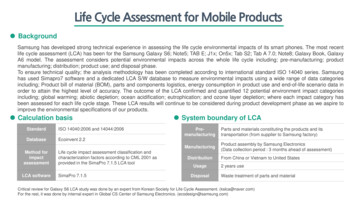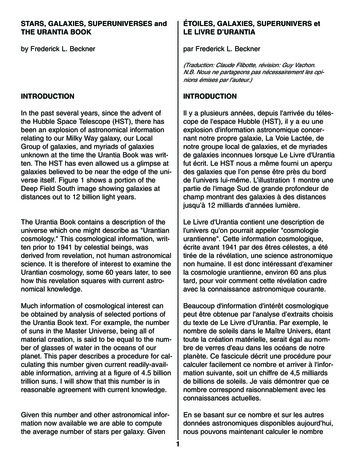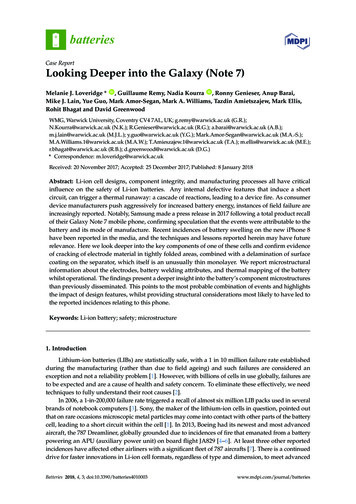
Transcription
TheMilkyWayGalaxy
The first description of theformation of the Galaxy waspublished by the Germanphilosopher Immanuel Kant(1724-1804) in his 1755book, the Allgemeine Naturgeschichte und Theorie desHimmels. The graphic inour book shows the samebasic idea.
Because the Sun in situated in the plane of the MilkyWay, as we scan around the sky, we see a band oflight. Perpendicular to the plane of the Milky Waythere are many fewer stars. Some constellationshave lots of star clusters, like Sagittarius, Scutum,Scorpius, and Cygnus. Other constellations such asComa Berenices cover the North Galactic Pole. Wesee few Galactic star clusters here but many externalgalaxies.Wm. Herschel (17381822) and his sisterCaroline (1750-1848)
William Herschel's 1785 model of the Galaxy placed usclose to the center of flattened system of stars. Buthe did not know about the effect of interstellar duston his star gauges.
In the early part of the 20th century J. C. Kapteyn (1851-1922)produced a very similar model of the Galaxy to that ofHerschel. He too did not take into account the effect ofinterstellar dust.
Why are Cepheids so important?a. We know their luminosities, so we can determinetheir distances.b. They produce pulsars.c. They are about to explode as supernovae.d. They generate most heavy elements.
What type of star makes a Type II supernova?a. A neutron star in a mass-transfer binary.b. A black hole.c. A pulsar.d. A single massive star.
Rank these associations of stars from those withthe fewest stars to those with the most stars:a.b.c.d.globular clusters, galaxies, open star clustersopen star clusters, globular clusters, galaxiesopen star clusters, galaxies, globular clustersgalaxies, globular clusters, open star clusters
Meanwhile, a very important tool for Galactic astronomywas being exploited by a young astronomer from Missouri.In 1912 the Harvard astronomer Henrietta Leavitt (1868-1921)discovered that the brighter Cepheid variable stars in theLarge Magellanic Cloud had longer periods than the Cepheidswith shorter periods. This is the famous period-luminositylaw.
Since the stars in the Large Magellanic Cloud are allat approximately the same distance from us, arelationship between their apparent magnitudes andperiods implied a relationship between their intrinsicluminosities (i.e. absolute magnitudes) and periods.Harlow Shapley (1885-1972) noticed that most of theglobular clusters in the sky were situated in theconstellations Scorpius and Sagittarius. He wondered:“Is the center of the Galaxy the same as the centerof the globular cluster system?”
Shapley determined the distances to a number of globularclusters using the period-luminosity law for Cepheids.He noted that most globular clusters had linear diametersof about 25 pc. He could then use their angular diametersto get approximate distance for clusters whose stars weretoo faint to study individually. He discovered thatthe center of the globular cluster system was situated inSagittarius at a distance of some 50,000 light years.However, he did not take extinction by interstellar dustinto account. Modern determinations of the distanceto the center of the Galaxy place it at a distance of about25,000 light-years, or about 8000 parsecs.
After Copernicusmoved the Earth fromthe center of the solarsystem, Shapley movedthe Sun from the centerof the Galaxy.Looking ahead, it appearsthat no matter what directionyou look, distant galaxiesare receding from us.Is our Galaxy at the centerof the universe?
Essentially all of thegas, and all of thebright blue stars arefound in the plane ofthe Galaxy.
Because we are situated insidethe Milky Way Galaxy, andoptical light is extinguished byinterstellar dust so much, itis difficult to get a picture ofour galaxy. But we feelconfident that the side-onand face-on views must besimilar to these two othergalaxies.
The star-gas-star cycle of the Galaxy
So, as new generations of stars are formed, thefraction of elements heavier than helium in thenew starsA. stays about the sameB. decreasesC. definitely increases
A spectrum of the Orion Nebula reveals many emission lines.
Just like the planetsin the solar system,stars further out inthe Galaxy orbit theGalactic center moreslowly. The Sun ismoving 220 km/sectoward Cygnus andorbits the center every240 million years.
Unlike the solar system, however, the circular speeds aroundthe center do not decrease nicely in accord with Kepler'sThird Law.
Your book gives estimates of the mass of the Galaxy from1 to 4 X 1011 solar masses. A more recent determinationof the mass of the Galaxy is even larger, 1.5 X 1012solar masses. This is on the basis of the motions ofglobular clusters (Watkins et al., 2019, ApJ. 873, 18)absolute magnitude called horizontal branch stars.The visible Galaxy that gives off most of thelight is embedded in a halo of invisible Dark Matter.What could this dark matter be? Relic particles from theBig Bang? Lots of 3 solar mass black holes? This isone of the biggest mysteries in modern astronomy.
Different Stellar Populations
Gas is confined to the Galactic plane, with a thicknessof only 100 pc. This is where the most recent starsare being formed.Perturbations of stars' motion by giant molecularclouds and star clusters has elongated the orbits ofother stars over time.Stars formed in the halo can have highly ellipticalorbits around the Galactic Center. These orbits arenot confined to the plane of the Galaxy.
Know thisfor finalexam!
The Sun is found in the plane of the Galaxy.It moves on a nice circular orbit around the centerof the Galaxy along with other stars formed inthe plane.If a halo star is passing through the plane, it willhave a large relative velocity with respect to theSun. So this is one way to identify a star thatis likely to have a different composition (muchlower abundance of elements heavier than helium) –it is a “high velocity star” that is just passing throughthe plane on an elliptical orbit toward the haloor toward the center of the Galaxy
Globular clusters were formed when the Galaxy was young.They have ages up to 10 to 13 billions years. Also, theoldest white dwarfs in the plane are now sort of orangein color. We can estimate that they may be 9 to 10 billionyears old. This is how we can get an estimate of the ageof the Galaxy.
Evidence for the spiral structure of the Galaxy comesfrom nearby associations of hot, new stars. Alsofrom observations of neutral hydrogen gas.
Spiral structure ofour Galaxy, asdetermined fromionized hydrogenregionsGeorgelin & Georgelin (1976)
We can map out the distribution of cold atomic hydrogenin our Galaxy by usinga. an optical telescope to obtain spectra of hydrogenemission nebulaeb. a radio telescope tuned to a wavelength of 21 cmc. an infrared telescope, because IR light is lessaffected by interstellar dust
The Sun and most of the stars near it are movinga. at all angles and velocities with respect tothe plane of the Galaxyb. on nearly circular orbits around the center ofthe Galaxyc. inevitably toward the black hole at the centerof the Galaxy
Most of the mass of the Galaxy is in what form?a. main sequence starsb. giant starsc. white dwarfsd. Dark Mattere. black holes
the plane on an elliptical orbit toward the halo or toward the center of the Galaxy . Globular clusters were formed when the Galaxy was young. They have ages up to 10 to 13 billions years. Also, the oldest white dwarfs in the plane are now sort of orange i










